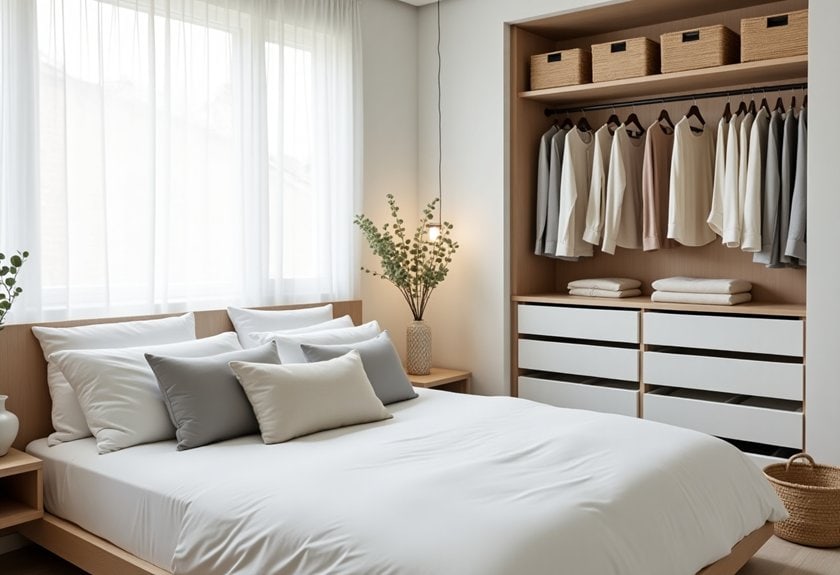Did you know that the average person spends about one-third of their life in their bedroom, yet most haven’t optimized this crucial space? Your bedroom should be more than just a place to crash at night – it’s your personal sanctuary where organization meets style. I’ve discovered some game-changing storage solutions that’ll transform your cluttered sleep space into a magazine-worthy retreat. From floating shelves that double as art displays to hidden storage spots you’ve never considered, you’re about to see your bedroom’s potential in a whole new light.
Floating Shelves for Decorative Storage
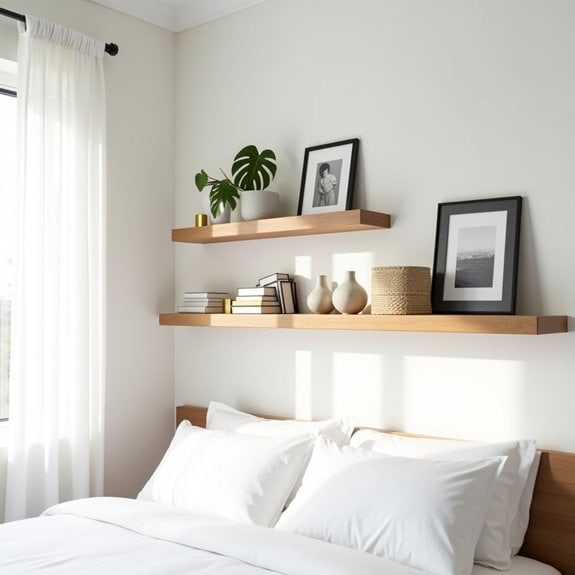
Organization Ideas for the Bedroom
Floating Shelves for Decorative Storage
Floating shelves represent a perfect blend of form and function in bedroom organization, offering valuable storage space while creating an aesthetically pleasing display. These wall-mounted solutions help maximize vertical space, keeping floors clear and creating an airy, uncluttered atmosphere in the bedroom.
By incorporating floating shelves into your bedroom design, you can showcase decorative items, store frequently used items within easy reach, and create visual interest on otherwise blank walls. This versatile storage solution works particularly well in smaller bedrooms where floor space is at a premium.
Required Items:
- Floating shelves (various sizes)
- Level
- Stud finder
- Drill and drill bits
- Screwdriver
- Wall anchors
- Measuring tape
- Pencil
- Decorative boxes or baskets
- Bookends
- Clear organizing containers
Start by selecting strategic wall locations for your floating shelves, using a stud finder to mark stable mounting points. Install the shelves at varying heights to create visual interest, ensuring proper weight distribution and following manufacturer guidelines for installation.
Group shelves in clusters or create a stepped arrangement for maximum impact and functionality. Organize items on the shelves by category, placing frequently used items at eye level and decorative pieces at varying heights. Incorporate decorative boxes and baskets to conceal smaller items while maintaining a cohesive look.
Position heavier items closer to shelf brackets for stability, and use bookends to keep books and magazines neat and upright. To maintain the aesthetic appeal and functionality of your floating shelf display, regularly assess and rotate items based on seasonal needs and usage patterns.
Consider incorporating plants, artwork, or personal photographs among stored items to create a balanced display that serves both practical and decorative purposes. Keep about 20% of shelf space clear to prevent a cluttered appearance and allow for future additions.
Under-Bed Rolling Drawers
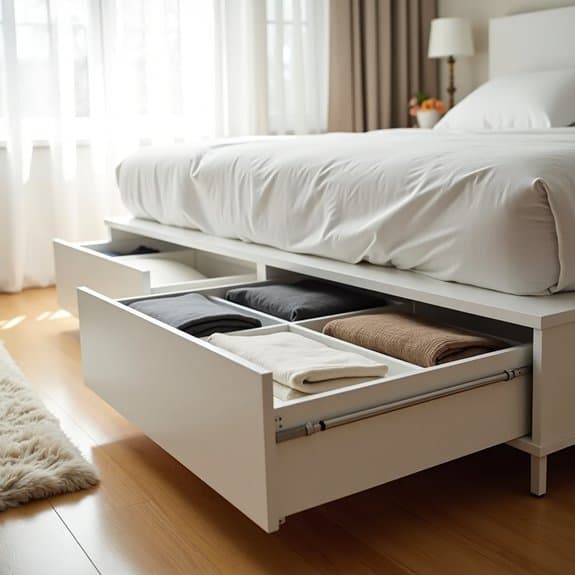
Under-bed storage represents one of the most underutilized spaces in the bedroom, offering valuable square footage for items that aren’t needed daily. Rolling drawers specifically designed for under-bed use transform this often neglected area into accessible, dust-free storage that can significantly reduce closet clutter and maximize bedroom organization.
The key to successful under-bed drawer organization lies in creating a system that’s both functional and easily accessible. Rolling drawers provide the perfect solution, allowing you to store seasonal clothing, extra bedding, or rarely used items while maintaining the ability to retrieve them without difficulty when needed.
Required Items:
- Under-bed rolling drawers (plastic or wooden)
- Drawer dividers or organizers
- Labels
- Measuring tape
- Vacuum cleaner
- Storage bags or compression bags
- Anti-moisture packets
- Drawer liners
Start by measuring the height clearance under your bed and the width and length of the available space. Choose appropriately sized rolling drawers that fit these dimensions while leaving enough room for smooth movement.
Before installing the drawers, thoroughly clean under the bed and consider laying down drawer liners to prevent dust accumulation.
Sort items into categories before placing them in the drawers, using drawer dividers to create designated spaces for different types of items. Place frequently accessed items toward the front of the drawers and seasonal items toward the back. For clothing and bedding, consider using compression bags to maximize space and protect against moisture and insects.
Additional Tip: Create a detailed inventory list of items stored in each drawer and attach it to the inside of your closet door or keep it in a household management binder. This practice prevents forgotten items and saves time when searching for specific pieces.
Consider adding small battery-operated LED strips along the bed frame to illuminate the drawers’ contents during retrieval.
Stylish Closet Organization Systems

A well-organized closet serves as the foundation for an efficient morning routine and a clutter-free bedroom. When closet spaces are thoughtfully arranged with proper organization systems, they transform from chaotic storage spaces into functional dressing rooms that make outfit selection effortless and clothing care simplified.
Installing a stylish closet organization system not only maximizes available space but also protects and preserves clothing investments while creating an aesthetically pleasing environment. These systems can be customized to accommodate specific wardrobe needs, from extensive shoe collections to formal wear, while maintaining a cohesive and attractive appearance.
Required Items:
- Closet rod organizers
- Hanging shelving units
- Drawer systems
- Clear storage boxes
- Matching hangers
- Shelf dividers
- Label maker
- Shoe racks
- Belt/tie/scarf organizers
- Storage baskets
- Measuring tape
- Level
- Basic tools (screwdriver, drill)
Start by removing everything from the closet and measuring the space, including height, width, and depth. Plan your organization system by zones: hanging space for long and short items, shelving for folded clothes, drawers for accessories, and designated areas for shoes.
Install the main components of your chosen system, ensuring proper anchoring to walls and level positioning. Add specialized organizers such as pull-out racks, drawer inserts, and shelf dividers based on your specific storage needs.
Arrange clothes by category and color, using matching hangers for a uniform look. Implement the chosen organization system methodically, placing frequently used items at eye level and storing seasonal or occasional pieces in higher or lower zones.
Utilize clear storage boxes for items that need protection from dust, and position shoes in dedicated racks or shelves for easy access.
Additional Tips: Maintain the organization system by implementing a “one-in-one-out” rule when acquiring new clothing items. Schedule quarterly reviews to assess the system’s effectiveness and make adjustments as needed.
Consider installing motion-sensor lighting to illuminate dark corners and make the space more functional. Use space-saving hangers and drawer organizers to maximize storage capacity while maintaining the aesthetic appeal of your closet system.
Bedside Storage Solutions

A well-organized bedside area serves as the command center for both starting and ending your day. From essential medications to reading materials, charging devices, and personal items, this space needs to function efficiently while maintaining a calm, clutter-free environment that promotes rest and relaxation.
Proper bedside storage not only keeps necessities within arm’s reach but also contributes to better sleep hygiene by reducing visual chaos and mental clutter. An organized nightstand area eliminates the frustration of searching for items in the dark and creates a more peaceful bedroom atmosphere.
Required Items:
- Bedside table or nightstand
- Drawer organizers or small bins
- Cable management solutions
- Storage basket or decorative box
- Reading lamp
- Small tray for frequently used items
- Multi-plug surge protector
- Drawer liners (optional)
- Labels (optional)
Start by completely clearing the bedside area and wiping all surfaces clean. Sort items into categories: daily essentials, reading materials, electronics, and miscellaneous items.
Install a surge protector for electronics and use cable management solutions to contain cords neatly behind or under the nightstand. Place drawer organizers inside drawers, creating designated spaces for smaller items like reading glasses, remote controls, and personal care products.
The nightstand’s top surface should remain minimal, featuring only a lamp, a small tray for immediate essentials (like glasses or water), and perhaps one decorative element. Store books and magazines in a dedicated drawer or attractive basket nearby.
For electronics, establish a charging station in one area of the drawer, using cord clips or guides to keep cables organized and easily accessible.
Additional Tips:
Maintain the organization by implementing a weekly reset routine, removing items that don’t belong and wiping down surfaces. Consider using a bedside caddy that hangs between the mattress and box spring for extra storage without taking up floor space.
Rotate reading materials regularly and keep only current items in the immediate area. To maximize space in small bedrooms, consider wall-mounted shelves or floating nightstands as alternatives to traditional bedside tables.
Wall-Mounted Jewelry Displays
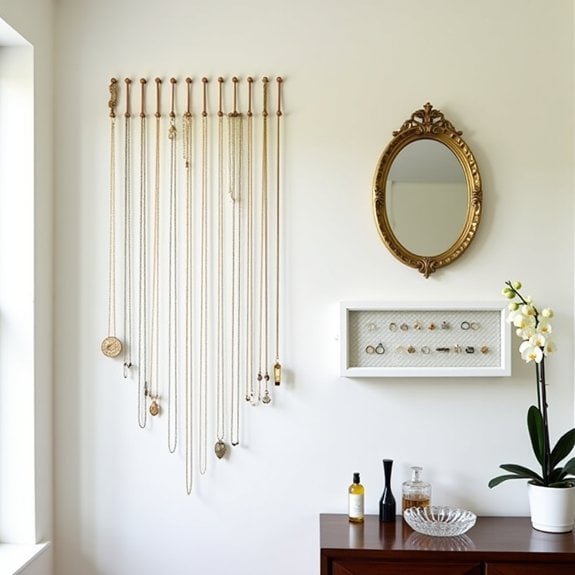
Organizing jewelry on wall-mounted displays transforms cluttered dresser tops and tangled necklaces into an artful, accessible arrangement.
Beyond mere storage, these displays turn jewelry collections into decorative elements that enhance the bedroom’s aesthetic while keeping precious pieces visible and protected from damage.
Wall-mounted jewelry organization eliminates the frustration of untangling chains and searching through boxes for matching earrings. This system allows for quick outfit coordination while preserving delicate pieces and preventing loss of small items that often disappear in traditional jewelry boxes.
Required Items:
- Decorative hooks
- Wall-mounted pegboard
- Picture frames
- Mesh screen or fabric
- Wall anchors
- Screwdriver
- Level
- Measuring tape
- Pencil
- Small screws
- Jewelry organizing inserts
- Command strips (optional)
Select a wall space near your dressing area and plan the layout by measuring the available space. Install wall anchors if needed, ensuring proper support for heavier pieces.
Mount your chosen display system, whether it’s decorative hooks arranged in a pattern, a pegboard with various attachments, or a mesh-lined frame. Position longer necklaces at eye level, with bracelets and watches below, and dedicate a separate section for earrings using screen material or specialized holders.
Group similar items together and consider color coordination for visual appeal.
Additional Tips:
Keep frequently worn pieces at easy-to-reach heights and rotate seasonal jewelry to maintain organization. Install proper lighting to showcase your collection and make selection easier.
Consider using clear drawer organizers below your wall display for extra storage of special occasion pieces or items requiring additional protection from dust and air exposure.
Multi-Purpose Ottoman Storage
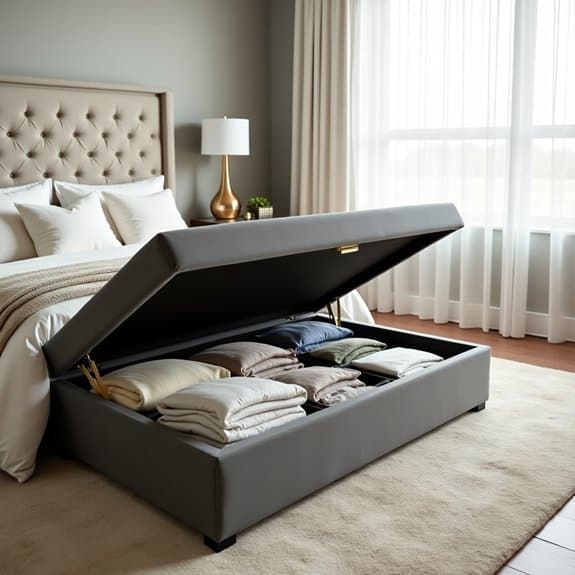
A well-organized ottoman can transform your bedroom storage capabilities while maintaining a clean, sophisticated appearance. This dual-purpose piece of furniture serves as both comfortable seating and a hidden storage solution for items that might otherwise clutter your living space.
Maximizing ottoman storage requires strategic planning and thoughtful organization to ensure easy access while protecting stored items. When properly organized, an ottoman can house seasonal clothing, extra bedding, reading materials, or even entertainment items while keeping them dust-free and readily available.
Required Items:
- Storage ottoman
- Storage bins or containers
- Drawer organizers or dividers
- Labels
- Fabric storage bags
- Compression bags (for bulky items)
- Anti-moisture packets
- Inventory list
- Clear plastic bags
To organize your ottoman storage, first empty the entire space and clean it thoroughly. Sort items into categories based on frequency of use and type. Use appropriately sized containers or fabric storage bags to separate different categories, ensuring they fit properly within the ottoman’s dimensions.
Place frequently accessed items near the top or front for easy reach. For clothing or bedding, utilize compression bags to maximize space while protecting items from dust and moisture.
Stack containers efficiently, with heavier items at the bottom and lighter ones on top. Consider using clear containers or detailed labels to quickly identify contents without having to remove everything. Create an inventory list of stored items and tape it to the inside of the ottoman lid for quick reference.
Additional Tips: Rotate stored items seasonally to prevent long-term compression and maintain fabric quality. Install small hooks inside the ottoman lid to hang the inventory list or frequently used items.
Consider using scented sachets or cedar blocks to keep stored textiles fresh, and regularly check for any signs of moisture or damage. Review contents every three months to ensure stored items remain relevant and necessary.
Custom Built-In Wardrobes
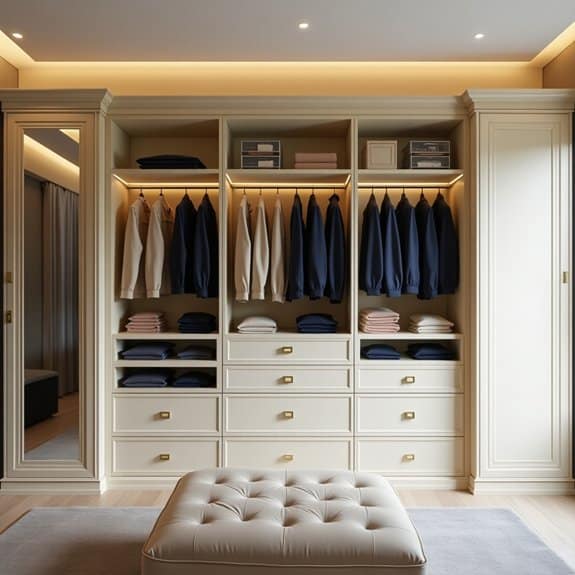
Custom built-in wardrobes represent a significant investment in both your home’s functionality and value. Unlike standard closets, these permanent fixtures can be tailored to your exact needs, maximizing every inch of available space while providing a seamless, sophisticated look that enhances your bedroom’s aesthetic appeal.
When properly organized, built-in wardrobes can transform your daily routine by creating designated spaces for every item of clothing, accessory, and personal belonging. This systematic approach to storage not only saves time during your morning routine but also helps maintain order and cleanliness while protecting your valuable garments.
Required Items:
- Wardrobe dividers
- Drawer organizers
- Hanging rod extenders
- Clear storage boxes
- Label maker
- Slim velvet hangers
- Shelf dividers
- Pull-out baskets
- LED lighting strips
- Drawer liners
Start by completely emptying your built-in wardrobe and categorizing all items by type, season, and frequency of use. Install drawer organizers and dividers according to your specific needs, ensuring frequently used items are placed at eye level.
Designate specific zones within the wardrobe: hanging space for longer garments, double-hanging areas for shirts and pants, and shelving for folded items. Utilize vertical space by installing additional hanging rods or shelves in taller sections.
Consider implementing a color-coding system or categorical arrangement that aligns with your lifestyle. Install LED lighting strips to illuminate darker corners and make items more visible. Use clear storage boxes on upper shelves for seasonal items or occasional-wear pieces, and ensure these are clearly labeled.
Maximize drawer space by using drawer organizers and implementing file-folding techniques for clothing.
Additional Tips: Maintain the organization by conducting seasonal audits of your wardrobe contents, removing items that haven’t been worn in the past year. Install hooks on empty wall spaces for belts, scarves, or frequently used items.
Consider adding a pull-out valet rod for planning outfits or hanging dry cleaning. Keep a small step stool nearby for accessing higher shelves safely, and leave some space for future additions to prevent overcrowding.
Vertical Shoe Storage Solutions
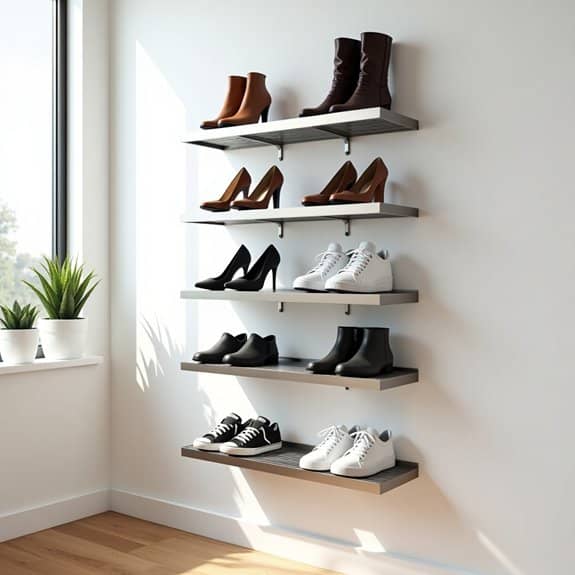
Maximizing vertical space for shoe storage has become essential in modern bedrooms where floor space is often at a premium. Proper vertical shoe organization not only helps maintain order but also protects your footwear investment while making each pair easily accessible.
Vertical shoe storage transforms otherwise unused wall space into functional storage areas, preventing shoes from cluttering the floor and creating trip hazards. This organization method also helps extend the life of your shoes by keeping them properly positioned and protected from dust and damage.
Required Items:
- Over-the-door shoe organizer
- Wall-mounted shoe racks
- Shoe hooks or clips
- Wall anchors and screws
- Measuring tape
- Level
- Drill
- Pencil
- Cleaning supplies
- Storage boxes for seasonal shoes
Begin by assessing your wall space and measuring the available area for vertical storage. Install wall-mounted shoe racks at a comfortable height, ensuring they’re properly anchored to support the weight of multiple shoes.
Position frequently worn shoes at eye level for easy access, with seasonal or special occasion footwear stored higher up. For maximum efficiency, arrange shoes by category (work, casual, formal) and consider using over-the-door organizers for additional storage on closet or bedroom doors.
Mount hooks or clips at varying heights to accommodate different shoe styles, from flats to boots. Ensure proper spacing between shoes to maintain airflow and prevent scuffing. For boots, use boot hangers or clips specifically designed to maintain their shape while stored vertically.
Additional Tips: Rotate your shoe collection seasonally, storing off-season footwear in protective boxes at the top of your vertical storage system.
Consider installing LED strip lighting along your vertical storage to illuminate shoes and make selection easier. Clean shoes before storing them vertically to prevent dirt from falling onto shoes below, and use shoe trees or stuffing in boots to maintain their shape while stored.
Drawer Dividers and Organizers
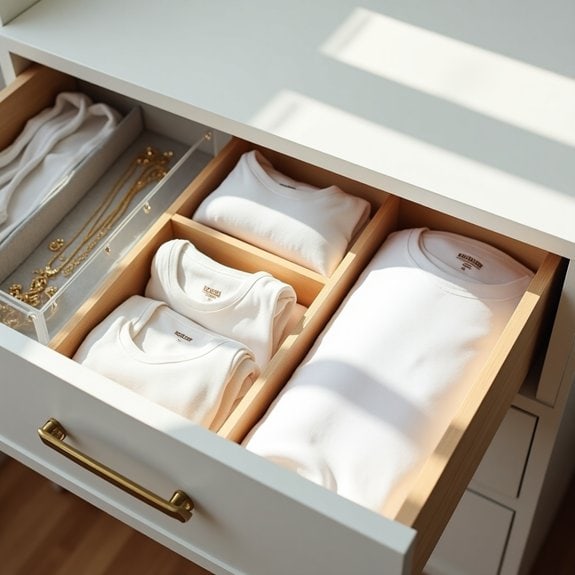
Well-organized drawers serve as the foundation for an efficiently managed bedroom. When everything has its designated space, finding items becomes effortless, saving precious time during daily routines and reducing the stress of searching through cluttered spaces.
Drawer dividers and organizers transform chaotic storage spaces into systematic compartments that maintain order long-term. This organization method prevents items from sliding around, keeps pairs together, and makes it easy to maintain categories of clothing, accessories, or personal items in their designated spaces.
Required Items:
- Drawer dividers (adjustable or fixed)
- Small organizing boxes or containers
- Drawer liner material
- Measuring tape
- Scissors
- Labels (optional)
- Storage bins for overflow items
- Cleaning supplies
Start by removing everything from the drawers and thoroughly cleaning the interior surfaces. Measure each drawer’s dimensions and plan your organization system based on the items you need to store.
For clothing drawers, use adjustable dividers to create sections for different categories like undergarments, socks, or accessories. In deeper drawers, stack small organizing boxes to maximize vertical space.
For maximum effectiveness, implement the file folding method within each divided section, allowing clothes to stand vertically rather than being stacked. This technique makes every item visible and accessible. Position frequently used items at the front of drawers and arrange similar items together.
Use clear containers for small accessories and drawer organizers with multiple compartments for jewelry or delicate items.
Additional Tips: Regularly assess and adjust divider placement as your storage needs change. Consider using scented drawer liners to keep contents fresh, and rotate seasonal items to maintain organized spaces year-round.
Remove items that haven’t been used in six months to prevent overcrowding, and always maintain a small amount of empty space in each drawer to prevent compression of stored items.
Hanging Door Storage Systems
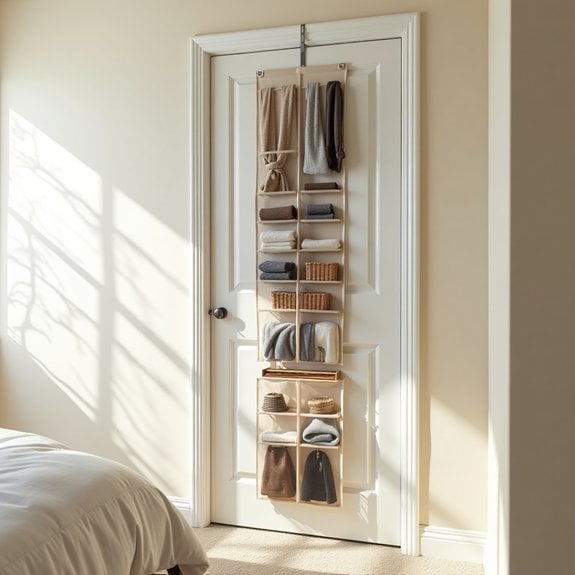
Maximizing bedroom storage often requires thinking beyond traditional closets and dressers. Door-mounted storage systems transform unused vertical space into valuable organizational real estate, making them perfect for smaller bedrooms or spaces that need additional storage solutions. These systems can hold everything from shoes and accessories to cleaning supplies and personal care items.
Hanging door organizers provide immediate visual access to stored items while keeping them off the floor and away from valuable surface space. This organizational method proves particularly effective for daily-use items, reducing the time spent searching through drawers or bins and maintaining a clutter-free environment.
Required Items:
- Over-the-door hooks or mounting brackets
- Door-mounted storage unit (shoe organizer, pocket organizer, or rack system)
- Measuring tape
- Level
- Screwdriver (if mounting hardware is required)
- Command strips or mounting anchors (optional)
- Labels or label maker
- Storage bins or baskets (optional)
Installation and organization begin with measuring the door’s dimensions to ensure proper fit of the storage system. Position the hanging mechanism at the top of the door, ensuring it’s level and secure. For screw-mounted systems, mark mounting points and install anchors if needed.
Once the system is properly mounted, sort items by category before placing them in the compartments. Arrange frequently used items at eye level, with heavier items toward the bottom for stability. Consider using clear pockets or labeled sections to maintain organization.
Additional success tips: Regularly assess the contents of your door storage system and rotate items based on seasonal needs. Avoid overloading individual pockets or compartments, as this can strain the mounting hardware and door hinges. For optimal functionality, maintain a 1-2 inch clearance between the storage unit and the floor, and ensure the door can fully close without interference.
Consider using small bins within larger pockets to contain smaller items and prevent them from getting lost in the depths of the organizer.
Clothing Rack Display Solutions
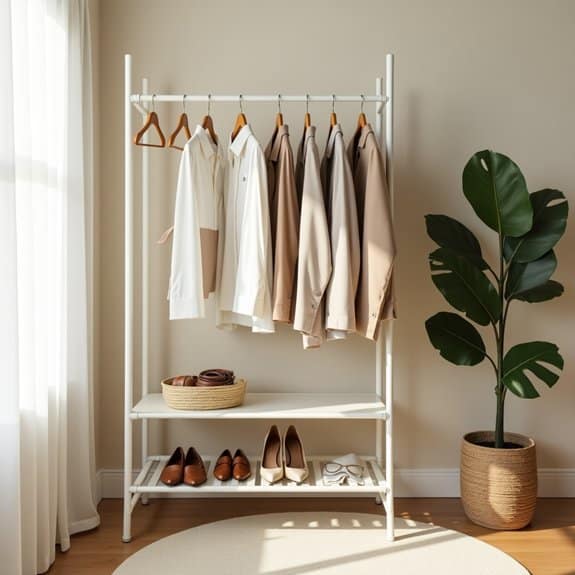
A well-organized clothing rack not only serves as a functional storage solution but transforms your bedroom into a boutique-like space where clothes become part of the room’s aesthetic. By displaying select pieces on a rack, you create easy access to frequently worn items while reducing closet congestion and preventing wrinkles in delicate fabrics.
Strategic clothing rack organization can revolutionize your daily routine by making outfit selection more efficient and enjoyable. When clothes are visible and properly arranged, you’re more likely to utilize your entire wardrobe and maintain an organized system long-term.
Required Items:
- Clothing rack (preferably with wheels)
- Matching hangers
- Garment dividers
- Storage bins or boxes
- Shoe rack (if rack includes bottom shelf)
- Closet rod dividers
- Small step stool
- Clothing rack cover (optional)
Start by positioning your clothing rack in a space with good lighting and minimal exposure to direct sunlight. Sort your clothes by category (tops, pants, dresses, etc.) and color coordinate within each section. Use matching hangers facing the same direction to create visual harmony and maximize space efficiency.
Install garment dividers between categories to maintain clear boundaries and prevent items from sliding together. For maximum functionality, arrange clothes according to frequency of use, with everyday items in the most accessible positions. Heavy items like coats and structured pieces should be hung on the ends to maintain the rack’s stability.
If your rack includes a bottom shelf, utilize it for shoes or storage boxes containing accessories or seasonal items. To preserve your organized system, implement a one-in-one-out rule when adding new pieces to the rack. Regularly assess the items displayed, rotating seasonal pieces and removing anything that hasn’t been worn in the past month.
Consider using a clothing rack cover if the rack is exposed to dust or direct sunlight, and always maintain adequate spacing between garments to prevent wrinkles and maintain the visual appeal of your display.
Basket Storage for Small Items
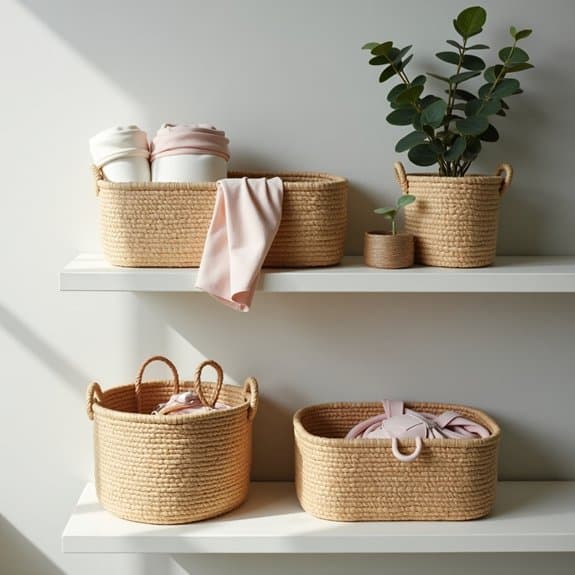
Small items in the bedroom can quickly become scattered and messy, creating visual clutter and making it difficult to find what you need when you need it. From hair accessories and jewelry to charging cables and reading materials, these items require a dedicated organization system to maintain order and accessibility.
Basket storage offers a versatile and aesthetically pleasing solution for managing small bedroom items. With various sizes, materials, and styles available, baskets can be integrated seamlessly into any bedroom décor while providing practical containment for daily essentials.
Required Items:
- Assorted storage baskets (various sizes)
- Labels or label maker
- Drawer dividers or small containers
- Measuring tape
- Clear plastic bags or pouches
- Sorting bins (temporary use)
- Container for items to donate/discard
Start by gathering all small items from around the bedroom and sorting them into categories such as accessories, electronics, personal care items, and reading materials.
Select appropriately sized baskets for each category, ensuring they fit your storage space, whether it’s a shelf, drawer, or under-bed area. Place similar items together in designated baskets, using smaller containers or drawer dividers within larger baskets to prevent items from mixing.
Label each basket clearly to maintain the organization system long-term. Position frequently used items in easily accessible locations, while seasonal or rarely used items can be stored in less convenient spots.
Consider using clear or open-top baskets for items you need to access daily, making visual identification quick and simple.
For optimal results, implement a regular maintenance schedule to review and reorganize basket contents. Remove items that are no longer needed, clean the baskets periodically, and adjust the organization system as your needs change.
Consider using moisture-absorbing packets in baskets storing delicate items, and avoid overcrowding baskets to maintain easy access and prevent damage to stored items.
Vanity Organization Ideas
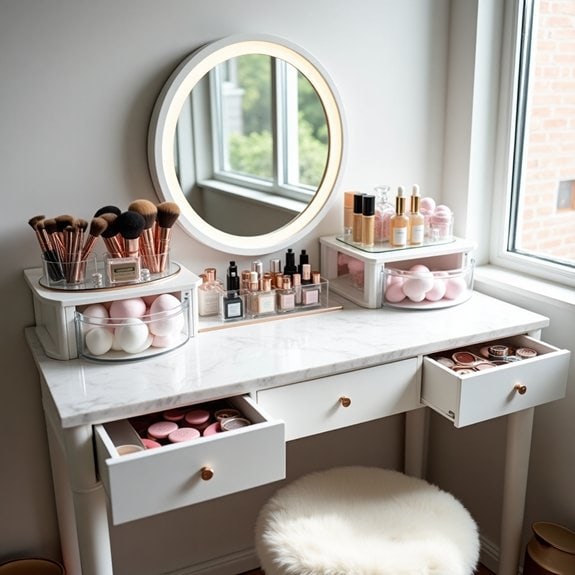
A well-organized vanity is essential for maintaining an efficient morning routine and creating a relaxing space for self-care. When makeup, skincare products, and beauty tools are properly arranged, you can easily access everything you need without wasting time searching through cluttered drawers or scattered items.
An organized vanity not only saves time but also helps preserve the quality of your beauty products by keeping them properly stored and visible, preventing forgotten items from expiring unused. Additionally, a tidy vanity space can transform your daily beauty routine from a chaotic rush into a peaceful, spa-like experience.
Required Items:
- Drawer organizers/dividers
- Clear acrylic containers
- Makeup brush holders
- Small storage bins
- Labels or label maker
- Drawer liners
- Storage trays
- Makeup organizers
- Cotton swab/cotton ball containers
- Small garbage bin
Start by removing everything from your vanity and sorting items into categories: makeup, skincare, hair products, tools, and daily essentials. Discard expired products and items you no longer use. Clean all surfaces thoroughly, including drawers and containers.
Install drawer liners to protect the surface and keep items in place. Arrange products by frequency of use, keeping daily items easily accessible on the vanity top using decorative trays or clear organizers. Store less frequently used items in drawers, using dividers to maintain separate sections for different categories.
Position your mirror in optimal lighting and arrange frequently used tools and products within arm’s reach of your primary sitting position. For enhanced organization maintenance, implement a regular monthly review system to check for expired products and maintain orderly arrangements.
Use clear containers whenever possible to easily identify products, and consider rotating seasonal items to storage when not in use. Label drawers and containers to maintain your organizational system, and keep a small waste bin nearby for daily cleanup.
Corner Shelf Storage Solutions
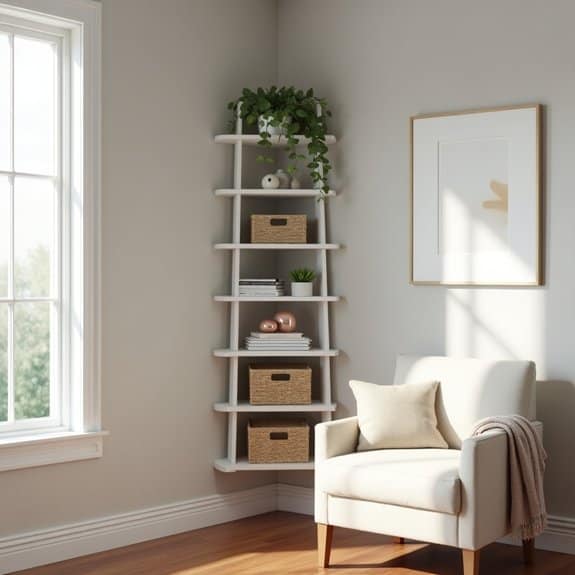
Corner spaces often become neglected dead zones in bedrooms, collecting dust or remaining completely unused. However, these overlooked areas present valuable opportunities for maximizing storage and displaying cherished items in an aesthetically pleasing way. Corner shelving can transform these awkward spaces into functional storage solutions that add both style and practicality to your bedroom.
By implementing corner shelf storage solutions, you can create vertical storage that draws the eye upward, making your room appear larger while providing dedicated spaces for books, decorative items, and everyday essentials. This organization method helps maintain a clutter-free environment while making efficient use of traditionally wasted space.
Required Items:
- Corner shelf unit
- Level
- Measuring tape
- Pencil
- Wall anchors
- Screwdriver
- Drill
- Dust cloth
- Storage baskets or bins
- Bookends
- Clear storage containers
- Labels
- Step stool
Start by thoroughly measuring your corner space, accounting for both width and height, ensuring adequate clearance for furniture and movement. Install the corner shelf unit according to manufacturer specifications, using wall anchors for stability and a level to ensure proper alignment. Position the shelves at varying heights to accommodate items of different sizes.
Organize items by category, placing frequently used items at eye level and less-used items on higher or lower shelves. Incorporate decorative storage boxes or baskets on lower shelves for items that need concealment, while using upper shelves for displaying artwork or plants. Create deliberate spacing between items to maintain a clean, organized appearance.
Additional Tips: Rotate items seasonally to maintain organization and prevent dust accumulation. Use clear containers for smaller items to maintain visibility while keeping them contained. Consider installing LED strip lighting under shelves to illuminate dark corners and create ambiance. Remember to leave some empty space for visual balance and future additions, avoiding the temptation to overcrowd the shelves.
Hidden Storage Headboards
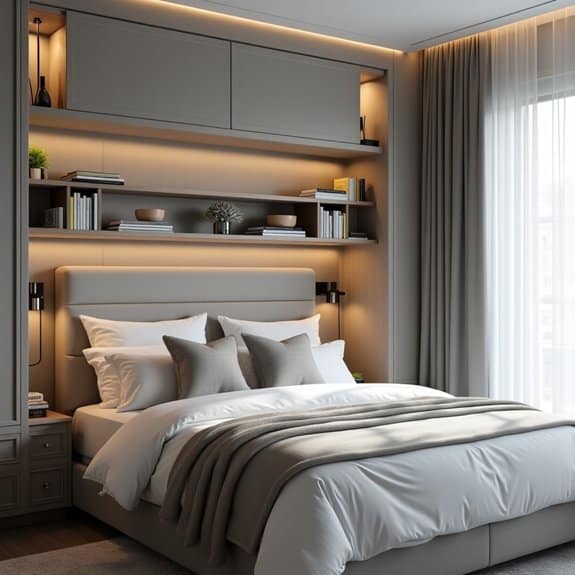
A well-organized hidden storage headboard transforms your bedroom by combining functionality with style. This often-overlooked space can store books, electronics, personal items, and bedtime essentials while maintaining a clean, uncluttered appearance in your sleeping space.
Hidden storage headboards are particularly valuable in small bedrooms where every square inch counts. By utilizing vertical space efficiently, these storage solutions free up precious drawer and closet space while keeping frequently used items within arm’s reach during bedtime or morning routines.
Required Items:
- Storage bins or baskets
- Drawer organizers
- Clear containers
- Labels
- Measuring tape
- Shelf liner
- LED strip lights (optional)
- Small hooks
- Dust cloth
- Container dividers
Start by emptying the headboard compartments completely and measuring each space. Install shelf liner to protect the surfaces and prevent items from sliding.
Group similar items together: reading materials, electronics and chargers, medications, and personal care items. Use clear containers or labeled bins to organize smaller items and prevent them from becoming jumbled. Position frequently accessed items in easily reachable compartments, while storing seasonal or rarely used items in less accessible areas.
For optimal organization, dedicate specific compartments to different categories. The top shelf might hold books and magazines, while side compartments could store reading glasses, remote controls, or charging devices. Install small hooks for hanging lightweight items like sleep masks or headphones.
If your headboard includes drawers, use drawer organizers to maintain order and prevent items from shifting during drawer operation.
To maintain this organization system, conduct monthly audits of stored items, removing anything that hasn’t been used. Consider adding LED strip lighting to illuminate compartments for better visibility. Keep a small dust cloth nearby for regular cleaning, and avoid overcrowding compartments to maintain easy access and prevent damage to stored items.

